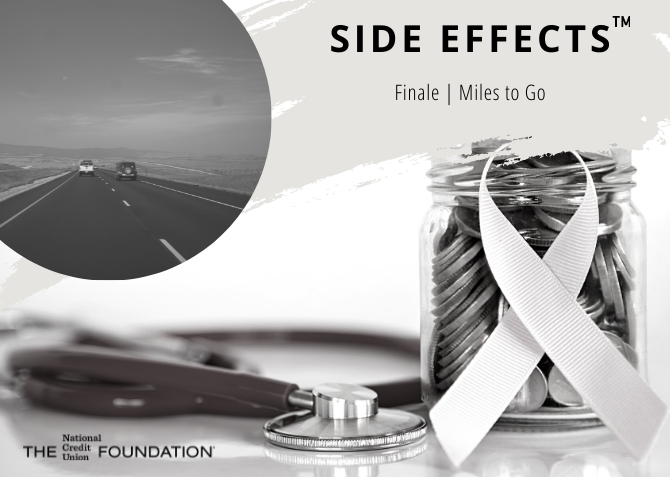Side Effects™, Finale: Miles to Go

Where do we go from here? The end of this documentary must herald some transformation that proves the financial crisis of cancer matters enough for us to fix it.
 The coronavirus pandemic gives us some clues. As Carla Tardif from Family Reach said back in Act 1, the relatively recent and acute impact of the coronavirus on our financial and physical well-being gave all of us a glimpse of what happens when a health crisis creates a financial crisis.
The coronavirus pandemic gives us some clues. As Carla Tardif from Family Reach said back in Act 1, the relatively recent and acute impact of the coronavirus on our financial and physical well-being gave all of us a glimpse of what happens when a health crisis creates a financial crisis.
In response, thousands of credit unions offered easy skip-a-pay options to their members. From how they’ve described it, Idaho Central Credit Union’s medical forbearance program continues the spirit of the program with members who have cancer. That is as good of a place as any for a credit union to start looking for ways to serve members in a season of overwhelming need.
But medical forbearance programs are just the beginning of a life-saving journey that our industry collectively, and each credit union individually, must take toward members battling cancer. We must prove their cancer matters enough to give members like Klara, Bernice, Lisa, Elizabeth, and countless others a healthy financial path forward despite their diagnosis.
Here are some ideas:
Start by making financial well-being for every credit union employee a strategic imperative. We’ve made the point several times before, but it bears repeating here – when you help your employees improve their financial and physical health, they’ll do the same for your members.
Regularly ask employees what they’re hearing and seeing from members about their health care and finances. This isn’t just about changing behavior, but about deeply understanding the external conditions affecting the behavior, the social determinants of health in your community, what your members experience daily, and how they feel about those experiences.
Resources include The Foundation’s DE Program; Financial Well-being for All webpage; and free Empathy eSchool.
Partner with doctors, cancer consortiums, and local hospitals that share your vision. Begin regular conversations with them about how you can work together to treat the mutual patient/member’s health and financial challenges. Health care providers have many competing priorities, especially as they evolve to meet increasingly complex community health needs.
Ultimately, though, your collaboration should demonstrably improve health outcomes, improve the patient experience, and reduce costs – a combined goal in healthcare known as Triple Aim45. And if you have healthcare providers and systems in your field of membership, collaborating under the banner of connecting health and financial well-being can only deepen that relationship.
Map your member’s journey through your products and services. Look at both critically and identify what adjustments should be made to improve the financial well-being of a cancer patient. Here are two examples of credit unions that have done just that:
Allegacy FCU (North Carolina)
Working with Wake Forest Baptist Health, in 2018 Allegacy created WellQ, a credit union service organization or CUSO. This innovative program strives to bridge the gap between physical and financial health and to offer consumers co-located health and financial advisors to facilitate information sharing, collaboration and improved outcomes.
Individuals, families, or businesses can join WellQ™ for an annual fee starting at $199. Membership is not currently available to those who are enrolled in certain government insurance plans (either as primary or secondary insurance) including TriCare, Medicaid/CHIP, or Medicare Part B.
To keep costs low for WellQ™ members, no insurance is accepted for medical treatment or prescriptions. Basic labs, such as a strep test, are included in the $35 clinic visit or telehealth virtual visit fee.
Town and Country FCU (Maine)
In response to the pandemic in 2020, the credit union partnered with the Maine Cancer Foundation (MCF) to offer a matching grant program to help cancer patients hard hit by the pandemic to have more financial resources to help get them through.
“The financial impact of COVID-19 on people going through serious illnesses, including a cancer diagnosis, is significant,” said David Libby, president and CEO of the credit union. “As an ongoing, major partner of MCF, we have been working on ways we could help. Our goal was to not only make it possible for additional support to be available but to highlight the additional financial challenges that cancer patients are going through as a result of the pandemic. We have a longstanding commitment and leadership role in financial wellness, and we believe this is consistent with how we can make a difference and ease the financial burden many of these patients are facing.”
This journey requires patience, creativity, and commitment. We hope all three have been buttressed in some way through Side Effects™, a project that causes your credit union to better see and serve the members who are fighting cancer.
With that in mind, I humbly offer a warning, born from my experiences with credit unions, talent development, and cancer – without a personal approach to procedures and staffing, the programs and interventions described thus far will fail our members, our colleagues, our communities, and even our industry’s mission.
Solving the financial crisis of cancer for our members can’t be just another bullet on the job descriptions of the incumbent member-facing branch and call center staff. We already rely on them to know virtually everything about deposit and loan policies and procedures, serve as the credit union’s unfailingly polished and professional face, and refer and close sales.
The members who qualify for cancer-related financial interventions have complex, far-reaching needs that are fundamentally different than the relatively routine, transactional demands of financially and physically healthy members.
As we’ve seen throughout Side Effects, members with cancer face too many impossible, life-threatening choices. They’re terrified about a suddenly uncertain future but don’t want to burden their loved ones and friends with their pain and turmoil. They’re grieving the unexamined life they used to live because no spot, lump, cough, fever, rash, upset stomach, headache, or body ache will ever be normal again.
Your members with cancer deserve a dedicated credit union professional – a Cancer Care Agent if you will – who can devote the time and expertise necessary to defend the member against cancer’s incessant financial assault.
The Cancer Care Agent will know the full range of the credit union’s financial mitigation options and connect the member with other assistance programs and organizations in the community and across the country.
The Cancer Care Agent must also have the bravery to empathize when the member is emotionally exhausted, and the stamina to guide the member through the financial minefield that may take months or years to cross.
The Cancer Care Agent model I’ve sketched out is a shameless rip-off of the Cancer Navigator program at Hendricks Regional Health, the network that saved my wife Karla’s life when she was diagnosed with breast cancer in August 2019.
Staffed by experienced Registered Nurses, many of whom worked on the floor of HRH for years, HRH’s Navigator program “is dedicated to promoting and coordinating a multi-disciplinary support for patients with cancer in a compassionate, patient-centered environment. The Navigator program is designed to help patients and their loved ones cope during the life-changing experience that is cancer.”
I can’t overstate the relief that Karla and I experienced by knowing we had Leanna and Alicia, our two Navigators, with us every step of the way when cancer crashed into our lives nearly two years ago.
Freed from the demands of regular nursing duties and empowered to serve our unique needs, Leanna and Alicia listened to us, cared about us, fought for us, and saved us. Their compassion, expertise, and courage blessed my wife and helped her heal.
If you replace the word “patients” with “members” in the Navigator description, you catch a hopeful glimpse of what a Cancer Care Agent program could do for members like Klara, Bernice, Lisa, and Elizabeth.
There is one other approach to the financial crisis of cancer, an intervention so unconventional that it changed the original ending of this documentary in ways I never anticipated. Don’t miss that final story in the Epilogue for Side Effects.
